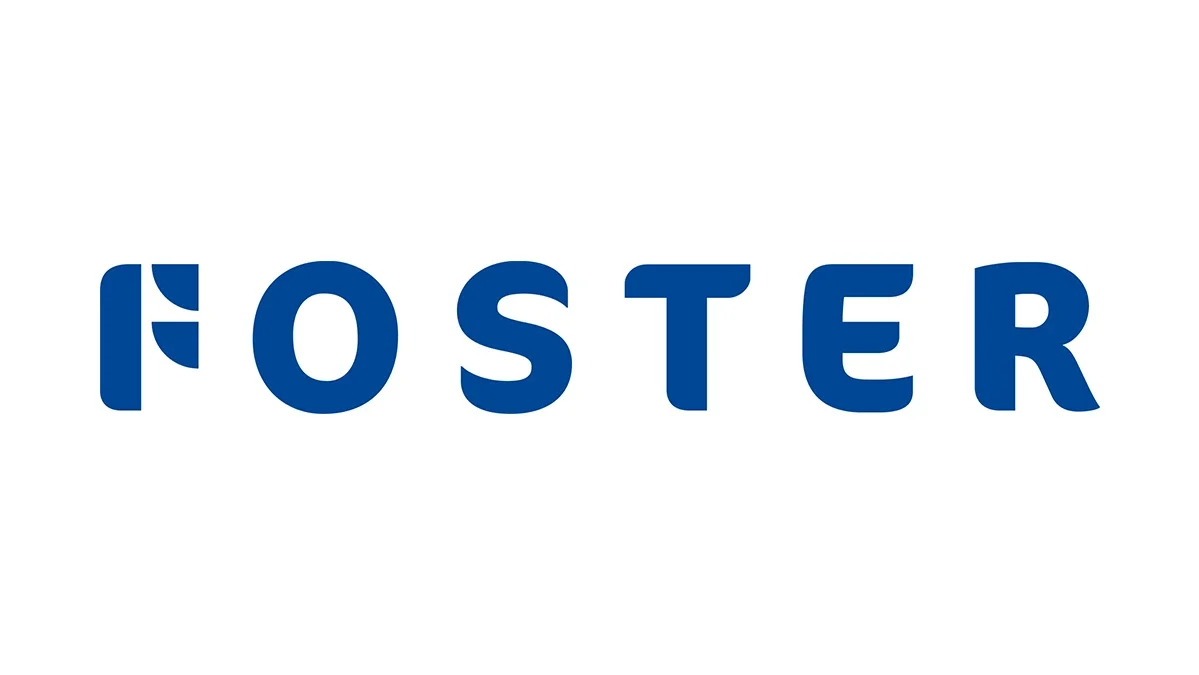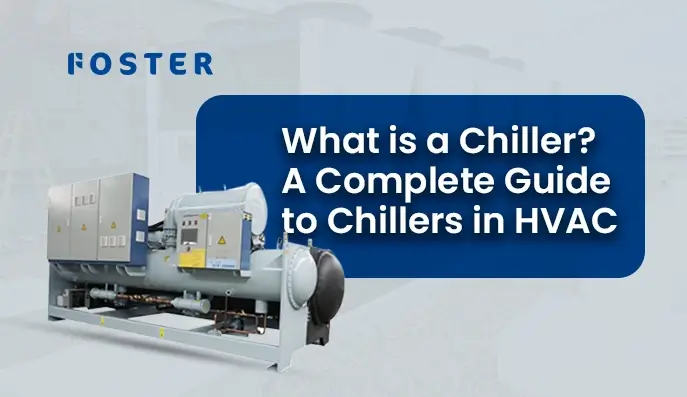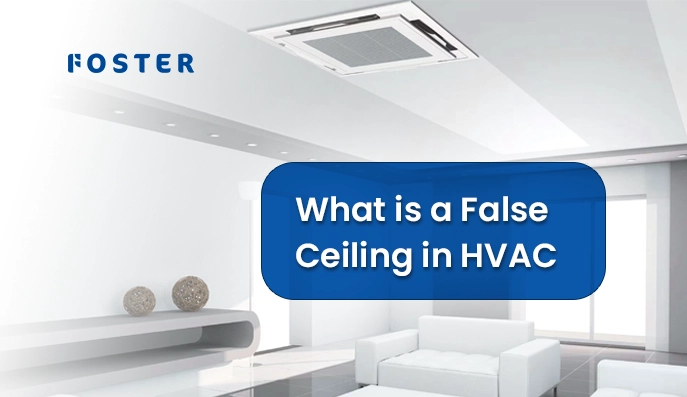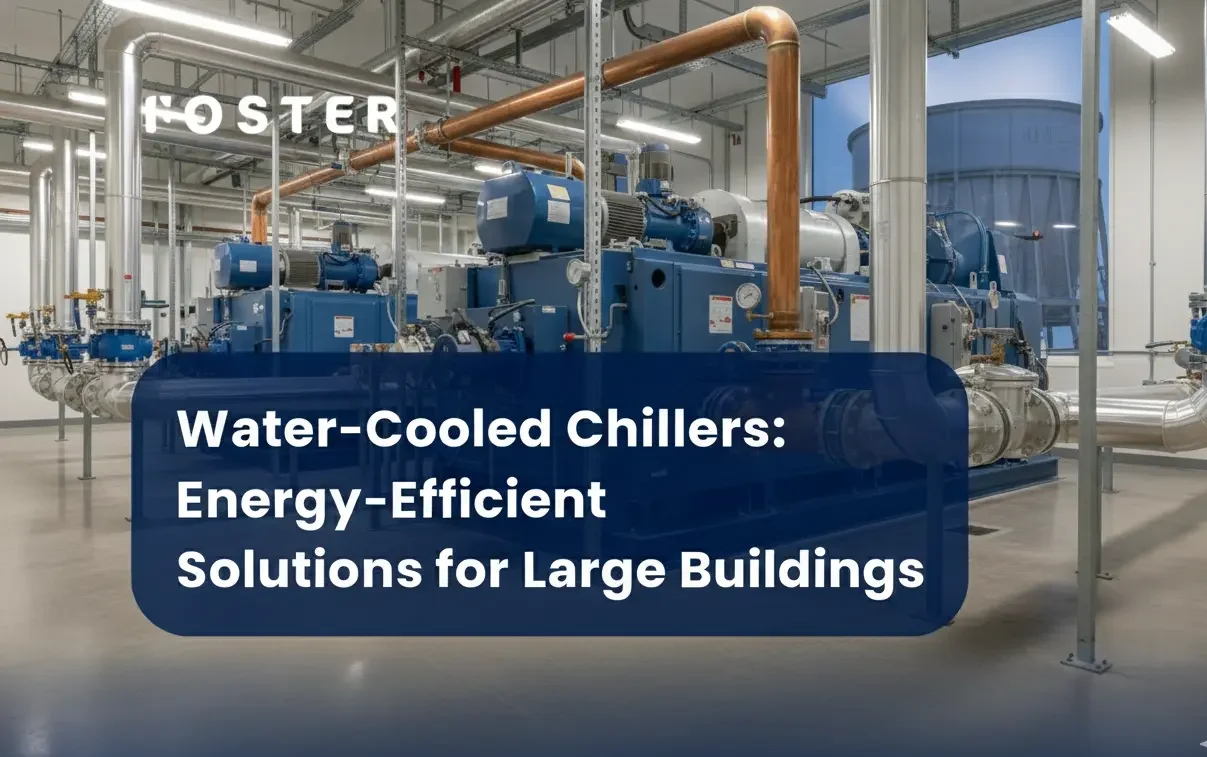A chiller is a mechanical device that removes heat from a liquid (typically water) through a vapor-compression or absorption refrigeration cycle. In HVAC systems, chillers are essential components that provide cooling for commercial buildings, industrial facilities, and large residential complexes by circulating chilled water through air handling units and cooling coils.
What Does a Chiller Do in HVAC Systems?
What is a chiller system? A chiller system is the centerpiece of big-time air conditioning systems, responsible for cooling buildings effectively and economically. Unlike home air conditioners that directly cool air, chillers cool water, which is pumped around a building to offer stable temperature control.
What is a chiller in HVAC? In HVAC systems, a chiller is the central cooling plant responsible for:
- Draws heat out of building spaces with the circulation of chilled water
- Provides accurate temperature control in numerous zones
- Delivers energy-efficient cooling to vast areas
- Enables industrial processes with temperature control needs
What is a chiller? The word “chiller” was coined from its core use—to “chill” or cool fluids below ambient temperature. In Dubai’s harsh climate, where temperatures commonly reach above 45°C (113°F), chillers are indispensable in keeping buildings comfortable. Understanding what is HVAC equipment helps contextualize how chillers fit into the broader cooling ecosystem.
How Does a Chiller Work?
Understanding how chiller works with diagram requires examining the four main components that work together in a continuous refrigeration cycle:
The Chiller Refrigeration Cycle:
- Evaporator: Chilled water enters at approximately 12°C (54°F) and exits at 7°C (45°F) as the refrigerant absorbs heat
- Compressor: Increases refrigerant pressure and temperature, requiring the most energy in the system
- Condenser: Releases absorbed heat to the atmosphere (air-cooled) or cooling water (water-cooled)
- Expansion Valve: Reduces refrigerant pressure, allowing the cycle to repeat
How Does a Chiller Operate?
The cycle starts when the building’s warm water returns to the chiller’s evaporator. The refrigerant in liquid form picks up heat from this water and evaporates into a gas. The gas is pressurized by the compressor and heated greatly. The hot refrigerant gas drops its heat and returns to liquid form in the condenser. Then, through the expansion valve, the pressure is reduced, and the process is repeated.
How Chiller Plant Works
A complete chiller plant includes:
- Primary chiller units
- Cooling towers (for water-cooled systems)
- Pumps for water circulation
- Air handling units throughout the building
- Control systems for optimization
For detailed refrigeration standards and safety guidelines, visit ASHRAE’s Refrigeration Resources.
Types of Chillers Explained
How many types of chillers are commonly used? There are several classifications based on different criteria:
| Chiller Type | Cooling Method | Efficiency | Best Application |
| Air-Cooled | Air | Moderate | Small-medium buildings |
| Water-Cooled | Water/Cooling Tower | High | Large commercial |
| Centrifugal | Water-Cooled | Very High | Large facilities |
| Screw | Air or Water | High | Industrial |
| Scroll | Air-Cooled | Moderate | Small commercial |
Air-Cooled Chillers
How air cooled chiller operates: Ambient air is used by these systems to dissipate heat from the refrigerant within the condenser. Fans circulate air over condenser coils, which makes them a good choice for applications where water usage should be minimized.
Water-Cooled Chillers
How water cooled chiller operates: These systems employ cooling tower water to shed heat from the condenser. Though more efficient, they need high water consumption—a factor in Dubai’s environment. When selecting water-cooled systems, proper equipment sourcing is crucial – explore our comprehensive HVAC equipment solutions for high-quality chiller units from trusted brands.
Centrifugal chiller
Centrifugal chillers utilize centrifugal compressors and are commonly water-cooled. They are the most efficient solution for large-scale cooling uses, most often encountered in mega-malls and high-rise buildings.
Blast chiller
Blast chillers are specialized chillers used for quick food cooling, which is most often utilized in restaurants and food-service industries in order to comply with health requirements. These specialized cooling applications often require complementary equipment like chilled water fan coil units for precise temperature distribution.
Chiller Temperature Guide: Ranges & How to Measure
What is chiller temperature? Chiller temperatures vary based on application and system design, but standard ranges are well-established.
Standard Temperature Ranges:
| Application | Supply Water Temp | Return Water Temp | Temperature Difference |
| Comfort Cooling | 7°C (45°F) | 12°C (54°F) | 5°C (9°F) |
| Process Cooling | 5°C (41°F) | 10°C (50°F) | 5°C (9°F) |
| Ice Rink | -7°C (19°F) | -2°C (28°F) | 5°C (9°F) |
| Cold Storage | -5°C (23°F) | 0°C (32°F) | 5°C (9°F) |
How to Check Chiller Temperature
What is the temperature for chiller monitoring? Key measurement points include:
- Chilled water supply temperature
- Chilled water return temperature
- Condenser water temperatures (water-cooled units)
- Refrigerant temperatures at various cycle points
Regular temperature monitoring ensures optimal efficiency and prevents system failures, especially critical in Dubai’s demanding climate conditions.
Choosing the Right Chiller Capacity for Your Needs
How to select chiller capacity depends on multiple factors, with cooling load calculation being the primary consideration.
Understanding Tonnage (TR)
How to calculate TR of chiller: One Ton of Refrigeration (TR) equals 12,000 BTU/hour or the amount of cooling needed to freeze one ton of water in 24 hours.
Capacity Calculation Formula:
Cooling Load (TR) = Flow Rate (GPM) × Temperature Difference (°F) ÷ 24
Key Performance Indicators
What is COP in chiller? Coefficient of Performance (COP) measures efficiency:
- COP = Cooling Output ÷ Energy Input
- Higher COP means better efficiency
- Typical COP ranges: 2.5-6.0 depending on chiller type
What is chiller approach?
Approach temperature is the difference between leaving condenser water temperature and ambient wet-bulb temperature. Lower approach temperatures indicate better heat transfer efficiency.
What is IPLV and NPLV in chiller?
- IPLV (Integrated Part Load Value): Weighted efficiency at various load conditions
- NPLV (Non-Standard Part Load Value): Efficiency at specific operating conditions
- These metrics help evaluate real-world performance beyond full-load ratings
What Does “Chiller Free” Mean in Dubai?
This term is unique to Dubai’s real estate market and refers to rental properties where cooling costs are included in the rent, rather than being charged separately by district cooling providers.
Dubai’s District Cooling System
Dubai utilizes centralized district cooling systems, particularly through Empower (Emirates Central Cooling Systems Corporation), which supplies chilled water to multiple buildings from central plants.
What is chiller free apartment? These are residential units where:
- Landlords pay chilling charges directly to the district cooling provider
- Tenants don’t receive separate cooling bills
- Rent typically includes all cooling costs
- More predictable monthly housing expenses for residents
Chiller Billing Models in Dubai
| Model Type | Who Pays | Typical Cost | Billing Method |
| Chiller Free | Landlord | Included in rent | Fixed monthly rent |
| Chiller Charged | Tenant | AED 0.30-0.50/sq ft | Monthly consumption |
| Hybrid | Shared | Varies | Usage-based sharing |
Maintenance & Troubleshooting
How to maintain chiller systems requires regular attention to prevent costly breakdowns, in harsh operating conditions.. Professional maintenance is crucial for optimal performance, and our comprehensive HVAC services include specialized chiller maintenance programs.
Essential Maintenance Tasks
Monthly Checks
- Refrigerant levels and pressure readings
- Water treatment and quality testing
- Electrical connections and controls
- Fan and pump operation verification
Quarterly Services
- Condenser and evaporator cleaning
- Filter replacement
- Calibration of temperature and pressure sensors
- Inspection of insulation and piping
Annual Overhauls
- Compressor maintenance
- Heat exchanger deep cleaning
- Refrigerant analysis and replacement
- Complete system performance testing
For facilities requiring consistent cooling performance, our Annual Maintenance Contracts (AMCs) provide comprehensive care that prevents costly breakdowns while ensuring optimal efficiency. Access to genuine HVAC spare parts is crucial for maintaining chiller performance and avoiding extended downtime.
Energy Efficiency
In energy-conscious environment, chiller efficiency directly impacts operational costs and environmental compliance.
Efficiency Standards
Dubai Municipality requires compliance with specific energy efficiency standards:
- Minimum SEER (Seasonal Energy Efficiency Ratio) requirements
- Regular energy audits for large commercial systems
- Incentives for high-efficiency equipment installation
For detailed information about Dubai’s green building standards, access the official Dubai Municipality Green Building Regulations.
ROI Considerations
High-efficiency chillers often pay for themselves through:
- Reduced electricity consumption (30-50% savings possible)
- Lower maintenance requirements
- Extended equipment life
- Improved system reliability
Professional Chiller Services in UAE
Foster International provides expert chiller solutions across the UAE, specializing in YORK and SKM systems. Our certified technicians ensure efficient, regulation-compliant service for commercial and industrial needs.
Services Offered
Installation
System design, equipment sizing, HVAC integration, and Dubai Municipality compliance.Maintenance
Preventive contracts, 24/7 emergency repairs, energy audits, and spare parts management.Consultation
Capacity planning, energy assessments, district cooling integration, and code compliance.
Conclusion
Chillers are the backbone of efficient cooling systems in Dubai’s challenging climate. From understanding the basic refrigeration cycle to selecting the right capacity and maintaining optimal performance, every aspect plays a crucial role in system success.
Whether you’re dealing with a chiller-free apartment, planning a new installation, or maintaining an existing system, professional expertise makes all the difference. The complexity of modern chiller systems requires specialized knowledge and regular maintenance to ensure peak performance and energy efficiency.
Contact Foster International for expert chiller solutions tailored to Dubai’s unique climate challenges. Our team ensures optimal performance, energy efficiency, and regulatory compliance for all your cooling needs.



 Previous Post
Previous Post


